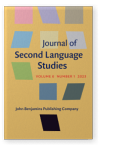Vol. 6:1 (2023) ► pp.61–94
Developing and evaluating a contextualized interactional competence rating scale based on a metaphorical conceptualization
A pragmatic mixed-method approach
Rating scales developed to measure interactional competence (IC) are mainly data-driven which can incur unaffordable costs for assessment practitioners with limited resources, such as universities using this test for placement purposes. A cheaper alternative is to use models proposed in the literature to develop such rating scales. This mixed-methods study evaluates a contextualized analytic IC rating scale developed based on Galaczi and Taylor’s (2018) metaphorical conceptualization of IC. A many-facet Rasch analysis indicated this rating scale could separate examinees into three levels of ability, which was lower than the expected four levels. To explore this finding, raters were interviewed about their experiences of using this rating scale. The findings show the potential and limitations of developing contextualized IC ratings scales based on literature and possible avenues for future research. They also suggest a direct interaction between assessment and instructional practices of IC with implications for language teaching.
Article outline
- 1.Introduction
- 2.Literature review
- 3.Material and methods
- 3.1Participants
- 3.2Materials
- 3.2.1Videos
- 3.2.2Rating scale
- 3.3Procedures
- 4.Results
- 4.1Quantitative analysis
- 4.2Qualitative analysis
- 5.Discussion
- 6.Conclusion
-
References
